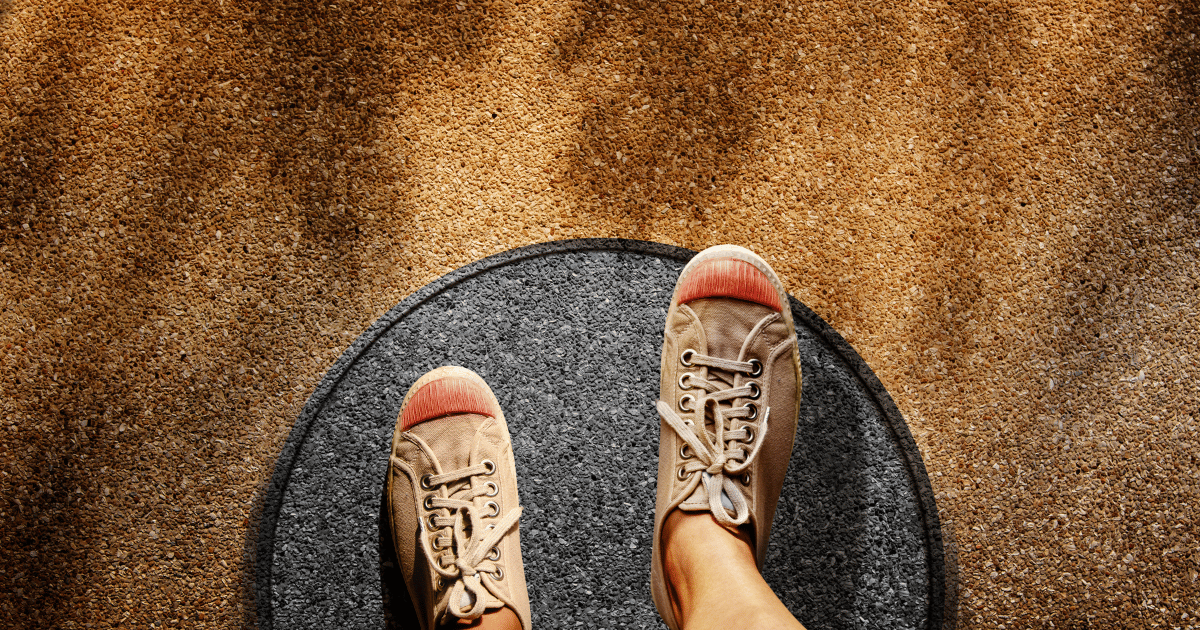Why Avoiding Discomfort May Be Holding You Back
A few weeks ago, I was sitting in my office trying to will myself into action—surrounded by half-finished projects, unanswered messages, and the quiet pressure of people waiting on me to move the ball forward.
Instead, I found myself hovering. You know that place—where you're technically in your chair, technically working, but actually spiraling into a silent negotiation with your nervous system.
Should I make a coffee? (A real, flavour-bursting drink, with frothed oat milk and Skor bits on top—because obviously that will help.) Should I check the fridge again, even though I’m not actually hungry? Maybe I’ll just do a little more research—because surely one more article, one more podcast, one more rabbit hole will give me the clarity I need to move forward.
This is the part where your brain, like a clever intern with no boundaries, starts pitching alternate plans. “What if we clean out our inbox? Or reorganize the files we haven’t opened since 2021? Or finally switch note-taking apps?”
Suddenly you’re very busy doing things that don’t matter—because doing something feels better than sitting in that vague, twitchy discomfort.
And yet… that’s the moment I want to talk about.
That moment right before you reach for the coffee or the scroll or the snack. That microsecond of ugh that we almost always try to fix or flee. Because here's the thing: discomfort doesn’t shout. It hums. It fidgets. It offers you a thousand ways out. And most of them feel like self-care… but they’re not.
They’re an escape.
Just then, Teresa walked in.
She didn’t say much—just glanced at me, then asked gently, “How are you doing?”
I paused, then exhaled a little too loudly. “I just need to get away and do something that feels better than this,” I said. “I’m feeling pressure. Like I’m behind on everything. And the longer I sit here, the more anxious I get.”
She nodded. Then, without judgment—but with that unnerving calm she’s mastered over the years—she offered some honest feedback.
“I don’t think you’ve had to sit with discomfort very often in your life,” she said. “You’ve definitely faced hard things. But most of the time, you’ve been able to move through them or around them. What if—this time—you didn’t? What if instead of chasing relief, you stayed? Maybe there's value in learning to sit with discomfort... not for its own sake, but for what might come through it.”
That sentence landed like a tuning fork in my chest. Because she was right. Not just about me, but about so many of us.
We’ve learned to chase comfort like it’s a virtue. But what if it’s not? What if the very thing we run from—that restless tension, the stuckness, the not-yet—holds the key to something bigger?
Because here’s what I’m continuing to observe:
Life begins outside the comfort zone.
And sometimes, the fastest way forward… is to stop trying to wiggle out.
The Convenience Trap: Why Comfort Isn’t Making Us Happier
We live in a world designed to keep us comfortable.
Thermostats pre-set. Meals delivered. Podcasts to drown out silence. An endless scroll of dopamine hits available in our pockets 24/7. We are, as a species, dangerously close to becoming allergic to inconvenience.
But here’s the paradox: the more we protect ourselves from discomfort, the more fragile we become in the face of it.
In their eye-opening book Look Again: The Power of Noticing What Was Always There, neuroscientist Tali Sharot and behavioral economist Cass Sunstein explore how we adapt—to everything. It's called habituation. Your brain, like an efficiency-obsessed assistant, learns to tune out anything that repeats too often—whether it’s a dripping faucet, a partner’s familiar kindness, or even your own anxiety.
At first, that sounds helpful. After all, who wants to be perpetually overwhelmed?
But the downside is sneaky. Over time, this tuning-out makes the extraordinary feel ordinary. It numbs us to both joy and discomfort. And when everything starts feeling “meh,” we chase stimulation instead of meaning. We mistake novelty for vitality. We scroll instead of sit. We snack instead of feel. We run instead of reflect.
But there’s good news.
Habituation works both ways.
If you can get used to tuning out the good, you can also get used to sitting with the hard. When discomfort is repeated in small, manageable doses, your brain stops freaking out. It recalibrates. What once felt intolerable becomes familiar. Not enjoyable, necessarily—but no longer threatening.
One study from Look Again makes this beautifully clear.
Researchers exposed participants to a loud, annoying sound. Halfway through, some were offered a break. Most jumped at it. The others stayed put.
Strangely enough, it was the ones who stayed that felt better by the end. Why?
Their brains adapted. The sound didn’t change. But their experience of it did. The discomfort lost its grip.
And that’s the magic. When you stay with the thing you normally escape, something unexpected happens:
You grow.
Three Small Ways to Practice Staying
If you're anything like me, your brain has perfected the art of slipping out the back door the moment discomfort walks in the front. So the trick isn't to “power through” or pretend you're fine. It's to get curious. To stay just a little longer—long enough to let your brain catch up and realize you're safe.
Here are three simple ways to start.
1. Catch yourself reaching—and pause.
Next time you're tempted to check the fridge again (even though you’re not hungry), or scroll just a little more, or make another coffee you don’t need… pause. Ask: What am I actually feeling right now? Is it boredom? Fear? Pressure? Let that moment teach you something. Not everything uncomfortable needs solving. Some things just need noticing.
2. Pick one thing you usually avoid—and don’t.
Choose a task you tend to dodge. A conversation you’ve been delaying. A form you’ve “forgotten” to fill out for three weeks. Then, stay with it for 10% longer than you want to. That’s it. Your job isn’t to finish it. It’s to stop fleeing it. The goal isn’t success. It’s stamina.
3. Schedule a dose of voluntary discomfort.
Weird, I know. But try it. Skip the background noise while you walk. Eat in silence. Sit still for 3 minutes before turning on anything. It’s disorienting at first. But over time, these micro-moments of quiet resistance retrain your brain. They remind you that being uncomfortable doesn’t mean you’re doing something wrong. Sometimes, it means you’re doing something sacred.
Discomfort is not a flaw in the system. It is the system—designed to sharpen, stretch, and shape you.
So maybe today, you don’t reach for the thing that numbs or fixes.
Maybe you just sit there. Breathe. Feel the hum.
And remember: Life begins outside the comfort zone.
Not because discomfort is good. But because staying with it helps you become someone even better.
Until next week, try taking a step outside your comfort zone,
Jonathan Penner | Co-Founder & Executive Director of LifeApp


Resources To Dig Deeper

Book
Look Again
In Look Again, Tali Sharot and Cass Sunstein reveal a powerful truth: the brain’s greatest enemy isn’t struggle—it’s sameness. Drawing from decades of neuroscience and behavioral research, this book explores why our minds tune out both the beauty and the brokenness around us, and how intentional disruption—what they call dishabituation—can reset our awareness and reinvigorate our lives. Whether in our work, relationships, or daily routines, Look Again shows that meaningful change begins the moment we step outside our comfort zones. It’s a compelling call to stop numbing, start noticing, and reclaim the vividness of being alive.
-Tali Sharot & Cass Sunstein

Video
No.1 Neuroscientist: Your Life, Your Work & Your Sex Life Will Get Boring! (THE FIX)
Neuroscientist Dr. Tali Sharot, in her conversation with Steven Bartlett on The Diary of a CEO, reveals why real transformation often starts just beyond the edges of comfort. Our brains, she explains, are wired for habituation—we quickly tune out even the good things in life when they become too familiar. Over time, this dulls our motivation, joy, and engagement. But there’s good news: novelty, challenge, and small doses of discomfort can reawaken our awareness and reignite a sense of purpose. Her research shows that people feel most alive when they’re learning, stretching, or doing something new—not when everything is easy. Growth, it turns out, isn’t the reward for avoiding discomfort. It’s the result of stepping into it.
-Dr. Tali Sharot, with Steven Bartlett (1:31:33)

Music
All Too Well (10-min. version)
This song is more than a breakup ballad—it’s a reflection on what it means to stay present with emotional discomfort rather than escape it. Through vivid storytelling and unresolved tension, the song invites listeners to sit with what’s hard, not to wallow, but to process and integrate—demonstrating how clarity, growth, and even strength can emerge when we resist the urge to escape what feels hard. It’s a reminder that transformation often begins not in fixing, but in staying.
-Taylor Swift (10:12)

